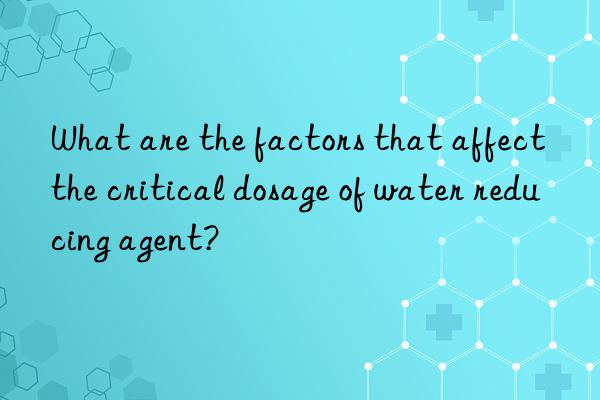
There is a question: What are the factors that affect the critical dosage of water-reducing agent? A person who has been in the chemical industry for many years said that the main factors are the type and quality of the admixture, the number of cores and the molecular chain of the water-reducing agent. The length and the water-cement ratio of the cement slurry, etc.
(1) Type and quality of admixtures
Various water reducing agents have different effects on increasing fluidity. Within a certain range, The fluidity increases with the increase of dosage, but when reaching a certain dosage, the effect of increasing fluidity no longer increases, that is, there is a critical dosage. The critical dosage of high-concentration β-naphthalene sulfonic acid condensate sodium salt is about 1.0%; the critical dosage of creosote sulfonic acid condensate sodium salt is about 1.0%; the low-concentration β-naphthalene sulfonic acid condensate sodium salt is about 1.0%. The critical dosage of the system is about 1.2%; the critical dosage of the melamine formaldehyde resin sodium sulfonate series is about 1.5%; the critical dosage of calcium gluconate, sodium lignosulfonate series, and polyvinyl phenolic ether are all about 0.5%.
(2) The number of nuclei and the length of the molecular chain of the water-reducing agent
In the basic research on β-naphthalene sulfonate formaldehyde condensate, it was confirmed that the critical doping of the water-reducing agent is The amount increases with the number of nuclei and molecular bonds.
(3) Water-cement ratio of cement slurry
Experimental research shows that the fluidity of cement slurry increases with the increase in the content of naphthalene series water-reducing agent, but its The effect and critical dosage vary depending on the water-cement ratio. When the water-cement ratio is low, the critical dosage is larger; when the water-cement ratio is high, the critical dosage is small.
After mixing an appropriate amount of water-reducing agent into the concrete, the water-cement ratio of the concrete can be reduced, the cement dosage can be reduced, the early strength of the concrete can be improved, the concrete form removal time can be advanced, the formwork turnover can be accelerated, and the construction period can be shortened. , reduce project cost.
Different cements have different clinker components. The higher the MgO content in the clinker component, the greater the impact of the water-reducing agent on the performance of the concrete, and the easier it is to cause micro-cracks in the concrete.
High-efficiency water-reducing agent has the property of selective adsorption of mineral clinker. When GA comes into contact with water, it will immediately have a sufficient adsorption layer. The greater the amount, the greater the amount of adsorbed high-efficiency water-reducing agent. However, less cS, especially c2S, is adsorbed. This uneven adsorption will cause the dispersion effect of high-efficiency water reducing agent to be different. c The higher the A content, the worse the compatibility between the cement and the water-reducing agent, which will cause the high-efficiency water-reducing agent to have insufficient water reduction or no water-reducing effect at all.
Experiments show that the setting time of concrete with water-reducing admixture is longer than that of concrete without water-reducing admixture.
In the concrete with high-efficiency water-reducing admixture, the setting and rheology of the concrete system characterized by low water-cement ratio are very different from those of cement mortar without water-reducing admixture. First, due to the reduction in water consumption, the dissolution of gypsum in the cement slurry is very small, and its concentration is not enough to control the hydration of C, causing rapid setting and rapid slump loss; second, the addition of high-efficiency water-reducing agent , interferes with the power of cement hydration, reduces the solubility of gypsum, and makes the concentration of gypsum in the liquid phase even lower. At the same time, due to the lack of sulfate ions, the sulfonate group on the superplasticizer molecule will combine with CA, reducing the dosage of superplasticizer in the liquid phase, losing its dispersion effect on cement, and accelerating slump loss.
</p

 微信扫一扫打赏
微信扫一扫打赏

